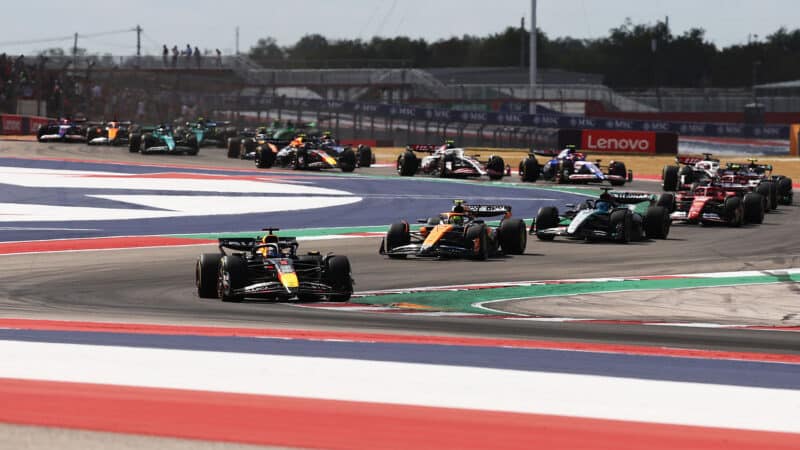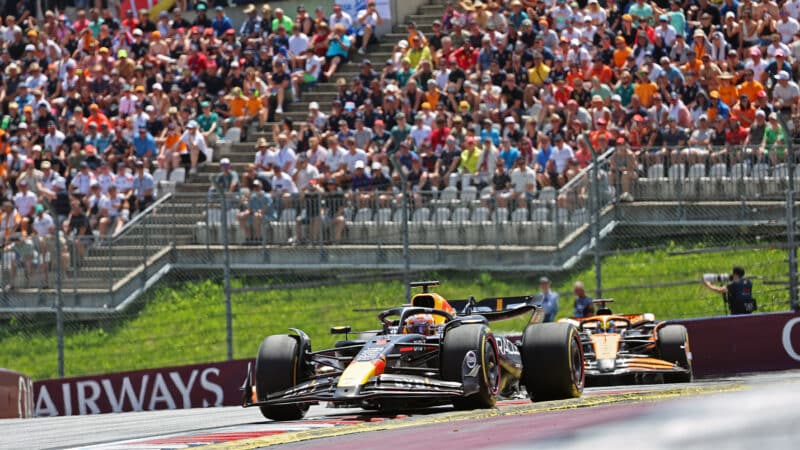How 2025 F1 sprint races work: qualifying shootout, points and schedule
The Chinese GP at Shanghai is set to host the first F1 sprint race of 2025, as part of a new calendar and refreshed format. Here's how sprint race weekends work, including the points awarded, race length and other changes this season

Verstappen leads this year's sprint at Austin
Red Bull
F1 sprint races are pocket-sized grands prix, being held at six race weekends this year, and aimed at producing faster, more frenetic on-track action without the need for pitstops and complex tyre strategies.
They consist of a separate Friday qualifying session, followed by a Saturday morning sprint that’s roughly a third of the length of the full race. The top eight drivers are awarded world championship points — the winner receiving eight, reducing to one point for the eighth-placed driver.
This weekend’s Chinese Grand Prix, held at the Shanghai International Circuit, is the first round of the 2025 F1 season to feature a sprint, running to the same schedule used in 2024. As before, drivers only have one practice session on Friday before the competitive action begins.
Sprint qualifying takes place on the Friday afternoon, then the sprint race itself is on Saturday morning. A eight- hour time difference between the UK and China means that you’ll have to be up early to watch the live action – or stay up late. The lights go out at 3am GMT.
The grand prix weekend timetable then returns to its familiar schedule with another qualifying session for the main race on Saturday afternoon and the grand prix itself on the Sunday.
It’s a change to previous years when both sprint and grand prix qualifying sessions took place first, ahead of both races.
The current format allows teams to change their car set-ups between the sprint race and qualifying. This enables engineers to take a more aggressive approach in the sprint and alter it for the longer grand prix.
How F1 sprint races work:
• Separate qualifying sessions Drivers compete in a pair of qualifying sessions: one after practice on Friday for Saturday’s sprint race, and one on Saturday for Sunday’s grand prix.
Saturday’s sprint race grid is determined by the ‘sprint shootout’:
– All 20 drivers have 12min to set a time in sprint qualifying 1 (SQ1)
– The five slowest drivers drop out before a 10min SQ2 session.
– Only the fastest ten go through to an 8min SQ3.
The sprint race then follows on Saturday morning.
Grand prix qualifying is unchanged:
– An 18min Q1 for all 20 drivers where the five slowest are eliminated.
– Followed by a 15min Q2 where another five drivers are dropped.
– Finally a 12min Q3 for the final ten drivers.
• Reduced practice There is only one hour-long practice session on a sprint weekend, limiting the amount of time to find the right set-up and simulate the different stages of the event. There are three hour-long practice sessions on a standard, non-sprint grand prix weekend.
• Championship points The winner of a sprint race gets eight F1 world championship points, which reduce by one per place down to the eighth-place finisher who receives one point.
• Six sprint weekends — the same as in 2023, and double the three held per season in 2021 and 2022
Scroll down for more details or click to jump to a particular section:
• 2025 Sprint race calendar
• 2025 sprint race rules – including sprint race laps, length, points, tyre allocation and penalties
• How sprint changes have affected F1 racing
• What is a sprint race?
2025 F1 sprint race calendar — schedule, results and start times
F1 is holding six sprint races this season, as it did last year. The sprint season begins at the second round of the 2025 season in Shanghai, with the second sprint taking place at May’s Miami Race.
The sprint then returns to Spa in July and then heads to fan favourites in COTA, Interlagos and Losail.
According to F1, each sprint calendar is designed to feature circuits which provide the most overtaking opportunities and therefore provide more entertainment for the fans and more point-scoring chances for the drivers. Last year saw some heated battles, but other sprint races were much more predictable.
2025 F1 sprint race rules
How long are F1 sprint races?
Sprint races run to 100km (62 miles). Lap count varies depending on the circuit. For the Chinese GP, the sprint race is set for 19 laps, which is just over a third of the 56-lap Grand Prix distance. There is also a time limit: races must be completed within 60 minutes, so if safety cars and stoppages take the action beyond an hour, it will be ended early.
F1 sprint race points table
The top eight finishers in the sprint race are awarded points. The winner receives eight championship points, reducing by one point per place.
| Position | Points |
| 1 | 8 |
| 2 | 7 |
| 3 | 6 |
| 4 | 5 |
| 5 | 4 |
| 6 | 3 |
| 7 | 2 |
| 8 | 1 |
2025 F1 sprint race qualifying format
Sprint races have a dedicated qualifying session. They no longer have a role in setting the grid for the grand prix and are held on a Friday after FP1.
Otherwise known as the ‘sprint shootout’, this qualifying session is shorter than for the grand prix in order to encourage drivers to set their fastest lap times right out of the gate. Those who are slow to start risk being knocked out and starting Saturday’s sprint race further down the grid.
Grand Prix qualifying retains the same format and is held on the Saturday after the sprint race has concluded.
Friday sprint shootout qualifying |
Saturday grand prix qualifying |
|||
| Session | Length | Drivers eliminated | Session | Length |
| SQ1 | 12min | 5 slowest | Q1 | 18min |
| SQ2 | 10min | 5 slowest | Q2 | 15min |
| SQ3 | 8min | n/a | Q3 | 10min |
Which F1 driver gets pole position on sprint race weekends?
The new sprint race weekend format has fallen in line with a regular grand prix weekend, with full-length qualifying still taking place on a Saturday. The fastest driver in this session, just like in every other grand prix weekend, will be on pole position for Sunday’s race.
This effectively eliminates any pole-sitter confusion, after an initial two years of awkwardness where there was only one qualifying session on a sprint weekend, which set the grid for the sprint race. Drivers then started the grand prix in their sprint finishing position.
For the first sprint races in 2021, pole position was officially awarded to the winner of the sprint race, which proved unpopular as it removed recognition of the all-or-nothing qualifying laps that showcase drivers’ bravery and commitment. That was changed in 2022, so that the fastest qualifier was recorded as pole-sitter. The 2022 F1 season stands as an historical quirk, being the only year when a grand prix weekend’s official ‘pole-sitter’ could potentially not start first in Sunday’s race (penalties aside).
When will penalties apply in sprint races?
Identical to other F1 race weekends, penalties incurred during FP1 or Saturday’s grand prix qualifying will applied to Sunday’s full-length grand prix.
However, penalties incurred during the ‘sprint shootout’ will be only be applied to the sprint race. Should a driver be handed a grid penalty during Saturday’s sprint race, that will then be applied to Sunday’s grand prix.
Power unit penalties will only apply to the grand prix.
Sprint race tyre allocation
Tyre restrictions are different during sprint weekends. Teams receive 12 sets, rather than the standard 13. When sprint shootout qualifying is dry, drivers must only use one set of tyres per stage: a fresh set of mediums in Q1; more unused mediums in Q2 and a set of new or used soft tyres in Q3.
There is a free choice of tyres for both the sprint on Saturday and the grand prix on Sunday.
Parc fermé rules
The new 2024 sprint weekend format comes with adapted parc fermé rules which allow teams to change the set-up of their car for sprint race and grand prix events.
There are now two parc fermé deadlines: one takes effect ahead of sprint qualifying on Friday afternoon and will last throughout Saturday’s sprint, preventing teams making significant changes to their car during this period. The other then starts ahead of Saturday afternoon’s grand prix qualifying session and continues until Sunday’s grand prix.
Last year, the parc fermé period ran from sprint qualifying until the end of the race weekend, so teams weren’t able to make set-up changes between the sprint race and the grand prix
How have sprint race changes affected F1 racing?
Sprint races had a major shake-up in 2024. With relatively few points at stake in the sprint (the winner gets eight as opposed to 25 in the grand prix), and no impact on their starting place in the next day’s grand prix — unlike the previous year — the idea was that drivers would be encouraged to follow their natural instincts and fight more aggressively, knowing that a mistake will prove less costly and won’t affect them on Sunday.
However this depends on cars having similar levels of performance. The first sprint of 2024 in China saw Verstappen qualify fourth, after a wet qualifying session, behind polesitter Lando Norris, Lewis Hamilton and Fernando Alonso. But after a short initial scrap, the world champion forced his way past and went on to establish a mighty 13 second lead by the chequered flag.
Victory in Miami was also relatively comfortable for Verstappen but he really had to earn his win in Austria after being harried by the much-improved McLarens.

Verstappen, harried by a McLaren, during the 2024 Austrian GP sprint
Grand Prix Photo
The fourth sprint of the season at the 2024 US GP in Austin was arguably the best of the year so far. While Verstappen may have led from the front, Lando Norris leapt from fourth to second by diving up the inside of George Russell and Charles Leclerc into the first turn.
Fierce battles then ensued over a number of laps as Russell attempted to get past Norris and Leclerc squabbled with team-mate Carlos Sainz, the two Ferraris frequently trading places.
Russell then fell behind the Scuderia pair, as Sainz chased after Norris. Under pressure, the British driver locked his front tyres at the start of the final lap, and Sainz seized third. The McLaren driver gamely hung onto third under intense pressure from Leclerc.
In Sao Paulo, Lando Norris finally overturned Verstappen’s streak of sprint race dominance. The Briton was beaten to pole by team-mate Oscar Piastri and trailed the Aussie for much of Saturday’s sprint race. But with just two laps remaining, the McLaren pairing were told to swap positions to aid Norris’ drivers’ title bid, and met the chequered flag in a comfortable 1-2 formation. Verstappen, who started the race in fourth, initially finished ahead of Leclerc in third, but was later given a time penalty for exceeding his delta under VSC conditions.
The final sprint of the year in Qatar was once again dominated by McLaren, as Lando Norris led from pole and Oscar Piastri found a way past George Russell at the start. Team Papaya then ran close together for the vast majority of the race distance, but at the final corner Norris slowed and allowed his team-mate to take victory — payback for Piastri’s show of sportsmanship in Brazil.
